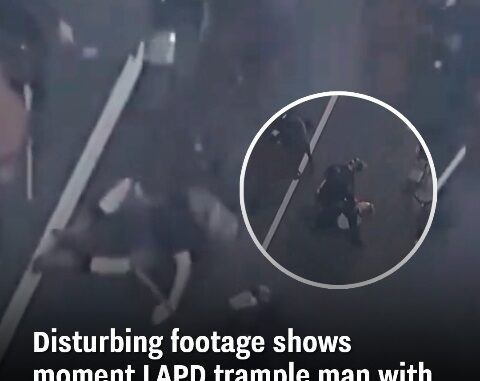
A disturbing incident during an anti-ICE protest in Los Angeles has sparked national outrage after a video surfaced showing LAPD officers trampling a man with police horses in a chaotic scene that unfolded over the weekend. The protest, held on Friday, June 6, brought hundreds of demonstrators into the streets to oppose aggressive Immigration and Customs Enforcement raids. What followed was a violent crackdown by riot police over three consecutive nights, turning downtown LA into a flashpoint of confrontation.
Footage shared widely on social media—and later broadcast on national television—captured the horrifying moment a protester wearing a backpack was knocked to the ground in the middle of a street. Surrounded by police both on foot and horseback, the man was first kicked by one horse, then stepped on by another. As if that wasn’t enough, a mounted officer struck him on the head with what appeared to be a baton. Although the man managed to get up briefly, a nearby officer grabbed him and forcefully threw him back down to the pavement.
The incident, now under review, has been widely condemned by civil rights organizations and sparked renewed debate over the militarization of police responses during protests. The video, which may be distressing for some viewers, reflects the volatility and escalating tension between law enforcement and demonstrators across the country.
According to authorities, the LAPD used rubber bullets and tear gas after officers were reportedly pelted with rocks and Molotov cocktails during the protests. However, many protesters and witnesses argue the police response was excessive from the outset, further inflaming an already tense situation.
Australian journalist Lauren Tomasi, who was covering the event for 9News, was caught in the middle of the chaos. “I’m okay,” she later confirmed. “My cameraman and I are safe. But what we witnessed tonight was extreme. The city is tense, and the streets are volatile.”
Tomasi reported that large sections of downtown Los Angeles had been cordoned off, with city officials warning that anyone entering restricted areas would be subject to immediate arrest. “The atmosphere is unlike anything I’ve experienced here,” she said, noting that residents were being told to avoid public spaces altogether.
In response to the escalating unrest, former President Donald Trump announced the deployment of 2,000 National Guard troops to Los Angeles. Posting on Truth Social, he declared, “If Governor Newsom and Mayor Bass can’t handle it—which everyone knows they can’t—the federal government will step in and solve the problem. Riots and looters will be stopped the way they should be.”
California Governor Gavin Newsom quickly responded, demanding that the federal government withdraw the troops. “This deployment is unlawful,” he wrote on X. “We had no problems until the Trump administration interfered. This is a dangerous violation of state sovereignty.”
Los Angeles Mayor Karen Bass also condemned the federal intervention, calling it “a blatant show of force” that only added fear to an already traumatized community. She pointed to Trump’s controversial use of the Alien Enemies Act of 1798, which has enabled expanded deportation powers, as the source of growing panic among immigrant families. “It’s terrifying,” she said. “People in our communities don’t feel safe—especially not now.”
Residents across the city remain shaken, with many expressing disbelief at the scenes of violence and the overwhelming show of force from both local and federal authorities. Advocacy groups are calling for an independent investigation into the protest response, as well as a broader review of police tactics involving mounted units in crowd control situations.
As national attention turns once again to Los Angeles, the incident has reignited urgent conversations about protest rights, policing practices, immigration policy, and the role of federal authority in local matters. What remains clear is that the man trampled in the street is no longer just a protester—he has become a symbol of a system in crisis, caught on camera for the world to witness.
Leave a Reply